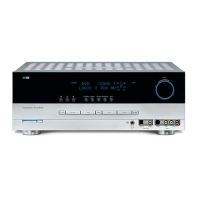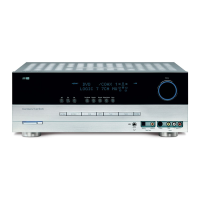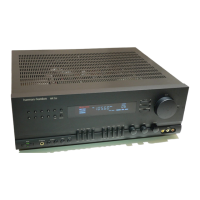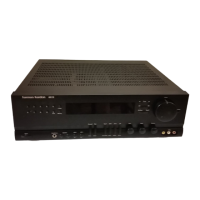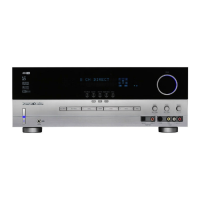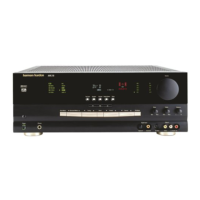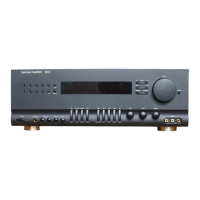OPERATION 33
OPERATION
Press the Mute Button f again to return to
normal operation.
•
You may adjust the bass and treble tone controls
at any point during a listening session by pressing
the
Tone Mode Button 5 until TONE IN
appears in the Lower Display Line ı. Press
t
he
T
one Mode Button
5 a
gain until either
TREBLE MODE or BASS MODE
appears in the Lower Display Line 5, and then
use the
‹/› Buttons ) to boost or cut the low
or high frequencies by up to ±10dB, in 2dB steps,
u
ntil the desired setting is achieved.
• You may also totally remove the tone controls from
the circuit so that the output is “flat” at any time by
pressing the
Tone Mode Button 5 and then
pressing the
‹/› Buttons ) so that TONE
OUT
appears in the on-screen display and the
Lower Display Line ı.
• The tone controls may also be adjusted using the
AUDIO SETUP submenu as described on
page 22.
• For private listening, plug the 1/4" stereo phone
plug from a pair of stereo headphones into the
front-panel
Headphone Jack
4
. When the
headphone plug is connected, all speakers will be
silenced and
DOLBY H:BP will scroll once
across the
Lower Display Line ı , indicating that
the headphone output is in the Bypass mode, and to
confirm that no processing is being used. When the
headphone plug is removed, the audio feed to the
speakers will be restored.
• When the headphones are in use, you may take
advantage of the Dolby
Headphone
modes to bring
added spaciousness to headphone listening
.
Press
the
Dolby Mode Select Button w or the
Surround Mode Group Selector 7 to cycle
through the three
Dolby Headphone
modes and
select the one that you prefer.
Surround Mode Selection
One of the important features of the AVR 240 is its
ability to reproduce a full multichannel surround sound
field from digital sources, analog matrix surround-
encoded programs and standard stereo programs.
Selection of a surround mode is based on personal
taste, as well as the type of program source material
being used. For example, motion pictures or TV pro-
grams bearing the logo of one of the major surround-
encoding processes, such as Dolby Surround or DTS
Stereo, may be played in either the Dolby Digital, Dolby
Pro Logic II or IIx Movie, DTS Neo:6 Cinema, or Logic 7
5.1 or 7.1 Cinema surround modes
.
NOTE: Once a program has been encoded with matrix
surround infor
mation,
it retains the surround information
as long as the program is broadcast in stereo. Thus,
movies with surround sound may be decoded via any of
the analog surround modes such as Dolby Pro Logic IIx
C
inema, Logic 7 Cinema or DTS Neo:6 Cinema, when
t
hey are broadcast via conventional TV stations, cable,
pay-TV and satellite transmission. In addition, a growing
number of made-for-television programs, sports broad-
casts, radio dramas and music CDs are also recorded
i
n surround sound.
Even when a program is not listed as carrying inten-
tional surround information, you may find that the Dolby
P
ro Logic IIx, Logic 7 or DTS Neo:6, VMAx and the Hall
or
T
heater modes often deliver enveloping surround
presentations through the use of the natural information
present in all stereo recordings.
Surround modes may be changed at any time by
using either the front panel or remote control. Any
changes made to the surround mode for that source
will be retained in the AVR’s menu, even after another
source is selected, or if the AVR is placed in Standby
mode. To select a new surround mode from the
front panel, first press the
Surround Mode Group
Selector Button
7 until the desired major surround
mode group (e.g., Dolby, DTS or Logic 7) is selected.
Next, press the
Surround Mode Selector Button 8
to choose the specific individual surround mode.
To select a surround mode using the remote, press the
button for the major surround mode group that
includes the mode you wish to choose from:
Dolby
w, DTS Surround x, DTS Neo:6 S,
Logic 7 y, Stereo R or DSP Surround k.
The first press of the button will show the current
mode from that group. To cycle through the available
modes in that group
,
press the button again until the
desired mode appears in the
Lower Display Line
ı, the on-screen display and in the Surround
Mode Indica
tors
ˆ.
As the surround mode changes
,
the appropriate
Surround Mode Indicator ˆ will light to indicate
the current mode. At times, it is possible that more
than one indicator will light. This can occur when the
DSP
Surround Off mode has been selected,
or when
post-processing is being used with an input signal,
such as when the Dolby Digital 2.0 plus Dolby
Pro Logic IIx mode is used to create a 7-channel
presentation of a two-channel signal.
The
Dolby Digital
,
Dolby
Digital
EX and DTS 5.1,
DTS-ES Matrix and DTS-ES Discrete modes may only
be selected when a digital input is in use and a digital
signal in that for
mat is present. In addition, when a
digital source is present, the AVR 240 will automatically
select and switch to the correct mode,
regardless of
the mode that has been previously selected. For more
information on selecting digital sources, see the Digital
Audio Playback section.
The Dolby Pro Logic IIx modes are available only when
the AVR 240 has been configured for 6.1/7.1 opera-
tion by setting the Surround Back speakers as either
L
ARGE
o
r
S
MALL
a
s described on page 27.
T
hese modes provide a matrixed 6.1-channel presen-
tation of analog sources.
When the 6-channel/8-channel direct inputs are in use
there is no surround processing, as these inputs take
the analog output signals from an optional, external
D
VD-Audio or SACD player, or another source device
and carry them straight through to the volume control
without any further digital processing.
To listen to a program in traditional two-channel stereo,
using the front left and front right speakers only (plus
the subwoofer, if installed and configured), press the
Stereo Button
R
until SURROUND OFF
appears in the Lower Display Line
ı
, or press the
Surround Mode Group Selector 7 until the Stereo
modes appear in the on-screen display and Lower
Display Line
ı
and then press the Surround Mode
Select Button
8 until SURROUND OFF
appears in the on-screen display and Lower Display
Line
ı
.
When an analog audio source is in use, you may
activate an analog bypass Surround Off mode; first,
remove the tone controls from the processing circuitry
by pressing the
Tone Mode Button 5 and using
the
‹/› Buttons )o until the TONE OUT
message appears in the Lower Display Line ı
,or
using the
AUDIO SETUP menu
.
If the tone controls are active (
TONE IN), or if
you have selected the digitized Surround Off mode,
the DSP icon will appear in the
Surround Mode
Indica
tors
R,
and the message
SURROUND
OFF
will appear in the lower line of the semi-OSD
display. The DSP icon indicates that the incoming sig-
nal is digitized and any bass management settings are
applied.
This mode is recommended when your front
speakers are not capable of reproducing the lower
frequencies and are thus used with a subwoofer.
When the DSP icon is not lit in Surround Off mode
with an analog audio input in use,
the AVR is in analog
bypass
mode.
The signal is being routed directly to the
volume control, without entering the digital domain and
without any bass management settings being applied.
This mode is desirable when your left and right speak
-
ers are capable of reproducing low frequencies, and
when you wish to hear the analog source material in
its pure form.
(Continued on page 36)
AVR 240 OM 4/7/06 4:08 PM Page 33
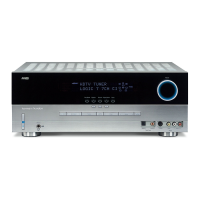
